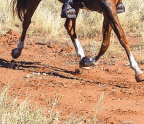
There’s a reason why nonsteroidal anti-inflammatory drugs (NSAIDs) are found in horse barns across America. Phenylbutazone, flunixin meglumine and other frequently prescribed NSAIDs are well understood, easy on the wallet and effective. Indeed, rare is the horse owner who hasn’t administered NSAIDs, under a veterinarian’s supervision, to ease a horse’s aches, pains or digestive discomfort.
Yet as familiar and indispensable as NSAIDs are, questions can still arise about how best to use them and what their effects might be. Of course, an internet search will yield plenty of general information. But for practical guidance, as well as insights that only experience confers, it’s best to turn to experts—veterinarians and researchers—with direct experience treating horses with NSAIDs. Of course, you’ll want to consult your veterinarian regarding your own horse’s care but read on for answers to common questions about NSAID use in managing equine injuries and diseases.
▶ NSAIDs are often prescribed to reduce pain associated with injury or illness. How are NSAIDs different from painkillers?
Reducing inflammation can alleviate discomfort, but NSAIDs are not considered painkillers. “Often, inflammation is the underlying problem causing the pain,” explains Duncan Peters, DVM, DACVSMR. “But a painkiller has a different mechanism of action—it merely targets pain, rather than quieting down the whole process in which one symptom is pain.”
Take, for example, one well-known class of painkillers: opioids. “These primarily act on the opioid receptors in the brain, diminishing the sensation of pain,” explains Mary Robinson, PhD, VMD, DACVCP. “Morphine is a classic example—it’s a drug that has been used for thousands of years.” A less potent analgesic option is acetaminophen (often sold under the brand name Tylenol for people), which is available over the counter.
Local blocking agents are another type of painkillers commonly used in horses. “These drugs block transmission of signals from the site of the pain to the brain,” says Robinson. “An example






